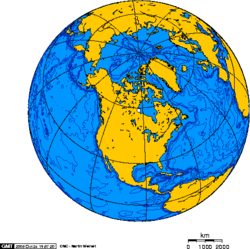
North America is the third largest continent, or a portion of the second largest if North and South America are combined into the Americas and Africa, Europe and Asia are considered to be part of one supercontinent called Afro-Eurasia. With an estimated population of 460 million and an area of 24,346,000 km² (9,400,000 mi²), the northernmost of the two continents of the Western Hemisphere is bounded by the Pacific Ocean on the west; the Atlantic Ocean on the east; the Caribbean Sea, Atlantic and Pacific oceans, and South America on the south; and the Arctic Ocean on the north. Canada covers most of the northern half of North America, much of which is sparsely populated, except for the northwestern portion which is occupied by Alaska, the largest state of the U.S. The central and southern portions of the continent are represented by the United States, Mexico, and numerous smaller states primarily in Central America and in the Caribbean.
North America consists of all the mainland and related offshore islands lying north of the Colombia–Panama border according to most sources, or the Panama Canal according to a few. The islands include Greenland, the world's largest island, and archipelagos and islands in the Caribbean. The terminology of the Americas is complex, but "Anglo-America" can describe Canada and the U.S., while "Latin America" comprises Mexico and the countries of Central America and the Caribbean, as well as the entire continent of South America.
Natural features of North America include the northern portion of the American Cordillera, represented by the geologically new Rocky Mountains in the west; and the considerably older Appalachian Mountains to the east. The north hosts an abundance of glacial lakes formed during the last glacial period, including the Great Lakes. North America's major continental divide is the Great Divide, which runs north and south down through Rocky Mountains. The major watersheds all drain to the east: The Mississippi/Missouri and Rio Grande into the Gulf of Mexico, and St. Lawrence into the Atlantic.
Climate is determined to a large extent by the latitude, ranging from Arctic cold in the north to tropical heat in the south. The western half of North America tends to have wilder and wetter climate than other areas with equivalent latitude, although there are steppes (known as "prairies") and deserts in the Southwestern United States of Arizona, Colorado, California, Nevada, New Mexico, Utah, Oklahoma, and Texas; along with the Mexican states of Baja California, Sonora, Chihuahua, Coahuila, Nuevo León and Tamaulipas.